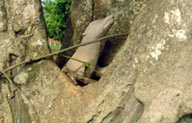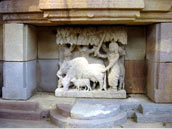Heritage Design
 |
 |
Retaining and respecting the spirit of the place was the guiding spirit during conceptulalisation and development of Ekamravana. The layout of the garden has three thematic sub-precincts - the Shiva pindi. the Parvati pindi and the Ganesha pindi. the Structure, theme and plants around each of the platforms are based on the identity of the deity after which the pindi is named. The Sanskrit word 'pindi' refers to kind of
raised hypothermal platform, often associated with worship and rituals in Hinduism.
Plants used for the worship of Lord Shiva adorn the Shive pindi. Plants useful for women healthcare have been planted around the Parvati pindi. Plants have been planted on his platform. The carving on each of the platforms relate to mythological stories associated with the particular deity.
The garden was created by craftsmen from Raghurajpur and Lalitgiri. The two centers have significant importance in the history and heritage of the region going back to several generations of master craftsmen. Raghurajpur, a heritage craft village situated near the abode of Lord Jagannath, has been recognised by UNESCO for its unique and multifaceted craft heritage. Lalitgiri is the seat of
tartaric Budhism were several relics with ornate carvings dating back to the 9th and 10th century have been excavated. More than 50000 man-days were devoted for the creation of Ekamravana between 2007 and 2010. Inputs and suggestions of a range of experts have been incorporated to make the place that it is today. Use of dry masonry technique to join the carefully selected and
meticulously crafted laterite and sandstone enhances the aesthetics of Ekamravana and is a living testimony to the dedication of the craftsman and the team that conceptualised, designed and executed the Ekamravana, the Garden of healing Spirituality
